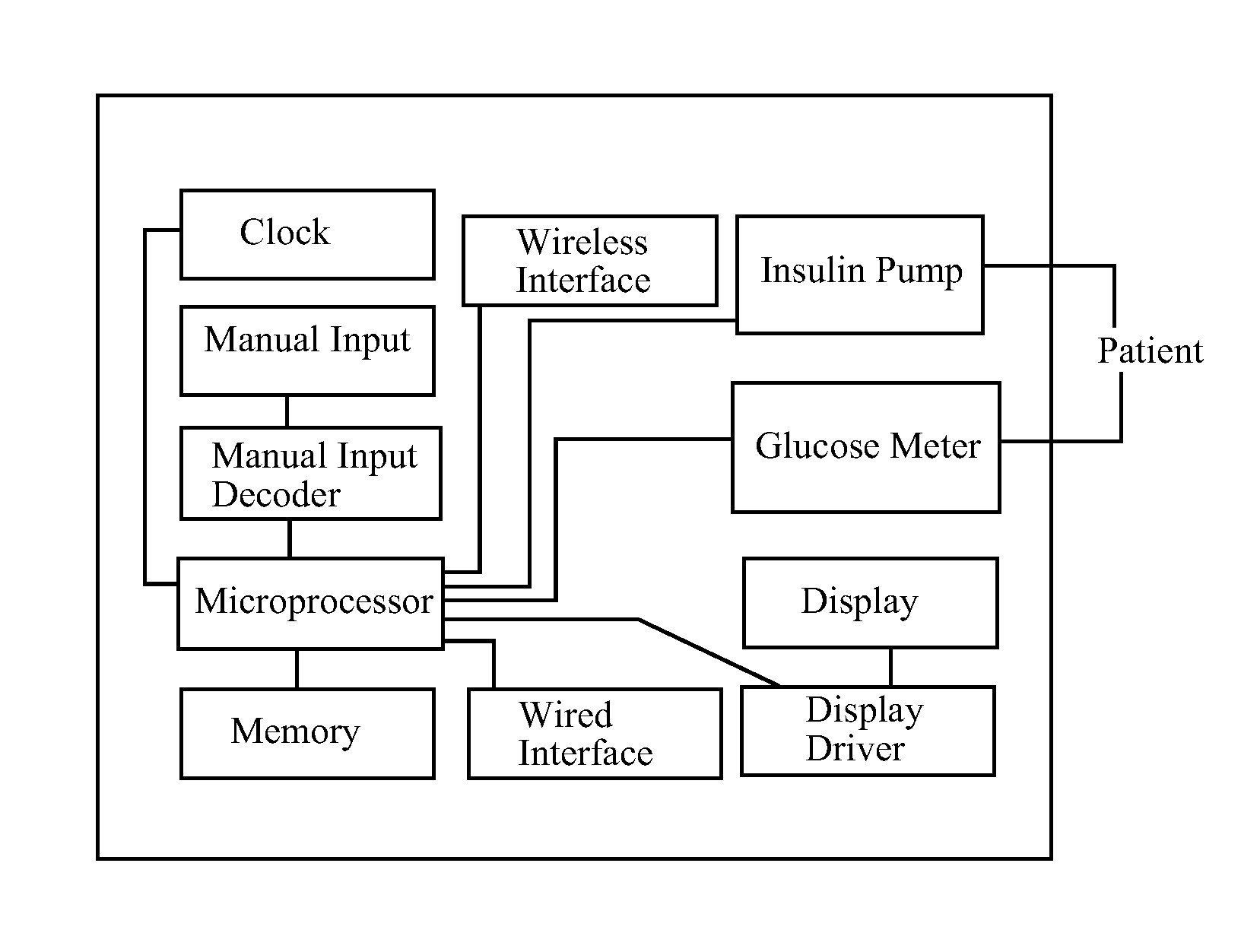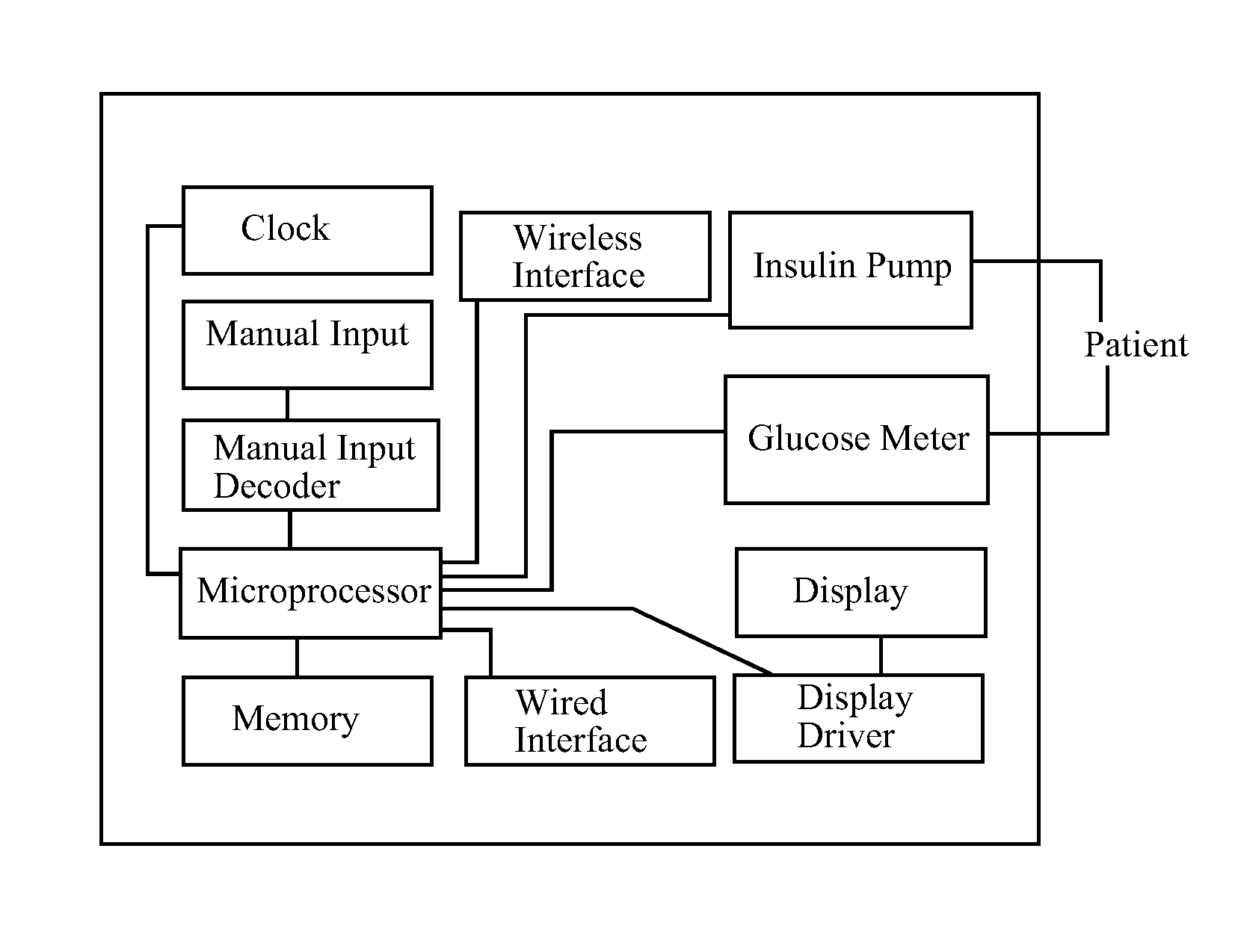Device for predicting and managing blood glucose by analyzing the effect of, and controlling, pharmacodynamic insulin equivalents
a technology of insulin equivalent and blood glucose, applied in the field of insulin delivery system and method for using insulin delivery system, can solve the problems of not being able to guarantee good blood glucose control, therapy does not by itself, and the timing and amount of insulin dosing is very difficult for human beings to figure out the amount of insulin dosing necessary for good bgc control
- Summary
- Abstract
- Description
- Claims
- Application Information
AI Technical Summary
Benefits of technology
Problems solved by technology
Method used
Image
Examples
example 1
[0255]Lisa uses an insulin pump to deliver aspart insulin subcutaneously and a conventional, point-in-time glucometer to measure her BGC. She has a system of the invention that calculates and displays amounts and rates of PDIUE expenditure from insulin delivery over time intervals beginning up to five hours in the past and ending up to seven hours in the future, based on insulin delivery data describing insulin already infused and insulin programmed to be infused, as obtained by communication with her insulin pump, and insulin already infused plus insulin programmed to be infused, as tentatively adjusted, as input by Lisa into her system in test mode. Lisa knows from experience that beginning about 2.5 hours after an Italian restaurant dinner, for which she has bolused insulin prior to mealtime according to her usual insulin-to-carbohydrate ratio, her BGC inevitably rises unless additional insulin is taken. However, the optimal amount and timing of that additional insulin has been d...
example 2
[0264]Lisa uses an insulin pump to deliver lispro insulin subcutaneously and a point-in-time glucometer to measure her BGC. She has a system of the invention, a stand-alone device that she keeps in her pocketbook, that calculates and displays amounts and rates of PDIUE expenditure from insulin delivery over time intervals beginning up to five hours in the past and ending up to seven hours in the future, based on insulin delivery data describing insulin already infused and insulin programmed to be infused, as obtained by communication with her insulin pump; it also imports BGC data by communication with her glucometer, and can, therefore, calculate and display BGC-neutral amounts and rates of PDIUE expenditure. Lisa knows from experience that pizza typically requires a standard bolus of insulin prior to mealtime according to her usual insulin-to-carbohydrate ratio, and in addition, an extended bolus of the same amount of insulin, plus or minus 25%, to be infused over 6 to 8 hours sta...
example 3
[0267]Lisa injects her glulisine insulin subcutaneously by syringe and uses a point-in-time glucometer to measure her BGC. She has a system of the invention that calculates and displays amounts and rates of PDIUE expenditure from insulin delivery over time intervals beginning up to five hours in the past and ending up to seven hours in the future, as well as BGC-neutral amounts and rates of PDIUE expenditure, based on insulin delivery data and BGC data that she manually inputs. Her system can also make BGC predictions when Lisa inputs predicted BGC-neutral amounts or rates of PDIUE expenditure. Lisa navigates her system's active calculation table (similar to the Calculation Tables associated with the examples in this specification) by scrolling times (by row) and data types (by column) using up / down and left / right arrows. She can read data from the calculation table, and she can input data using number keys and an enter button. At lunch Lisa ate a hamburger and a salad, for which sh...
PUM
 Login to View More
Login to View More Abstract
Description
Claims
Application Information
 Login to View More
Login to View More - R&D
- Intellectual Property
- Life Sciences
- Materials
- Tech Scout
- Unparalleled Data Quality
- Higher Quality Content
- 60% Fewer Hallucinations
Browse by: Latest US Patents, China's latest patents, Technical Efficacy Thesaurus, Application Domain, Technology Topic, Popular Technical Reports.
© 2025 PatSnap. All rights reserved.Legal|Privacy policy|Modern Slavery Act Transparency Statement|Sitemap|About US| Contact US: help@patsnap.com



